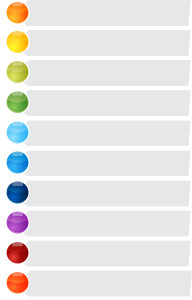Your Blog Isn’t a Container or Bin

“A talk isn’t a container or a bin that you put content in, it’s a process, a trajectory,” says Chris Anderson, head of TED Talks. “The goal is to take the listener from where he is to someplace new. That means trying to make the sequence so stepwise that no one gets lost along the way.”
A blog isn’t a container or bin that you put content in, either, and, particularly in the case of business blogging, the goal definitely is to take readers from where they are to someplace new.
“It’s especially important,” Anderson reminds speakers, “to do a jargon check. Any technical terms or acronyms that may be unfamiliar to your listeners should be eliminated or explained.” But what he is NOT advocating,” he hastens to say, “is that everything be explained on a level appropriate for sixth-graders.” At TED, he reminds readers, they use the guideline based on Einstein’s dictum: “Make everything as simple as it can be, but no simpler.”
When it comes to blogging, there are tests you can put your blog through to see how you’re doing in terms of readability – are you reaching the right people and doing it by using words and sentences to which they can relate? Well, a readability index calculator can give you the answer. Both Lexile and Flesch-Kincaid measure how easy your text is to read, based on what grade in school a person would need to have reached to be able to understand your content. (The reason Anderson specifically mentions sixth-graders is that a score of 6 would be considered optimal in journalism.)
What, exactly, do readability index calculators measure to take your readability “temperature”? Essentially, two things:
- The average number of syllables per word
- The average number of words per sentence.
On the other hand, you don’t want to insult your audience’s attention, Anderson cautions speakers. “Indeed, the best explainers say just enough to let people feel like they’re coming up with the idea themselves.” To create excitement in your audience, he says, start by making the talk relevant to them. After all, it’s not a given that anyone in the audience actually cares that much about your topic.”
In a sense, with blog readers, it IS a given that the audience cares about the topic. Online searchers arrive at your blog precisely because they have a need for the very kinds of information, products, and services you provide! Now that they’ve arrived, though, it’s up to you to take those readers to “someplace new” in their knowledge and thinking!

 “Establish order on the planet of your blog by using proven structures for your blog posts,” advises
“Establish order on the planet of your blog by using proven structures for your blog posts,” advises  “There’s little that our brains crave more than effortlessly acquired data,”
“There’s little that our brains crave more than effortlessly acquired data,” 
 Biomass is what scientists use when there’s no way to do an exact count, Bill Chapell explained in an NPR radio broadcast five years ago, referring to the “fact” that The Day We Hit 7 Billion (October 31, 2011), was actually impossible to prove; it is impossible to count all the world’s people alive at any particular moment. So, he says, the experts estimate by calculating biomass.
Biomass is what scientists use when there’s no way to do an exact count, Bill Chapell explained in an NPR radio broadcast five years ago, referring to the “fact” that The Day We Hit 7 Billion (October 31, 2011), was actually impossible to prove; it is impossible to count all the world’s people alive at any particular moment. So, he says, the experts estimate by calculating biomass.
Follow us online!